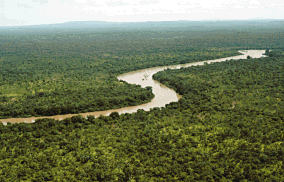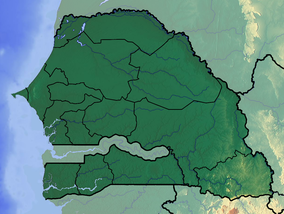Niokolo-Koba
| Niokolo-Koba National Park | |
|---|---|
|
IUCN category II (national park)
|
|

Gambia River in the national park
|
|
| Location | Senegal |
| Coordinates | 13°04′N 12°43′W / 13.067°N 12.717°WCoordinates: 13°04′N 12°43′W / 13.067°N 12.717°W |
| Area | 9,130 km2 (3,530 sq mi) |
| Established | 1954, 1969 |
| UNESCO World Heritage Site | |
| Criteria | Natural: (x) |
| Reference | 153 |
| Inscription | 1981 (5th Session) |
| Endangered | 2007– |
|
[]
|
|
The Niokolo-Koba National Park (French: Parc National du Niokolo Koba, PNNK) is a World Heritage Site and natural protected area in south eastern Senegal near the Guinea-Bissau border. It is served by Niokolo-Koba Airport, an unpaved airstrip.
Established as a reserve in 1925, Niokolo-Koba was declared a Senegalese national park on 1 January 1954. Expanded in 1969, it was inscribed as a World Heritage Site in 1981 as a UNESCO-MAB Biosphere Reserve. In 2007 it was added to the UNESCO List of Endangered World Heritage sites.
The park lies in an upland region through which the upper stretch of the Gambia River flows, towards the northwestern border of Guinea. The Biosphere park itself covers some 9,130 square kilometres, in a great arc running from Upper Casamance/Kolda Region at the Guinea-Bissau border into the Tambacounda Region to within a hundred kilometers of the Guinean border near the southeast corner of Senegal. Its altitude ranges from 16m to as high as 311m.
Most of the park is woodland savannah and semi-arid Soudanese forest, with large areas of wooded wetlands and seasonal wetlands. The park contains over 1500 species of plants and 78% of the gallery forest in Senegal.
Lots of trees and shrubs are covered by lush vegetation along the river stalks, and these vegetation changes according to the terrain and soil. In the valleys and plains, there are vast areas where Vetiveria and herbaceous savannah grow. Overgrown grasslands typically consist of the Paspalum arbiculare and the Echinochloa. Sudanian species grow in the dry forest. There are also areas where bamboo lives.
In valleys and belt-shaped forests, the species reflects the climate of southern Guinea, and the tropical woody liana is very prosperous.
...
Wikipedia

